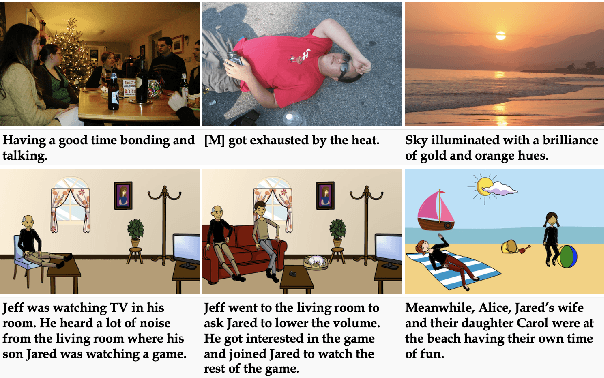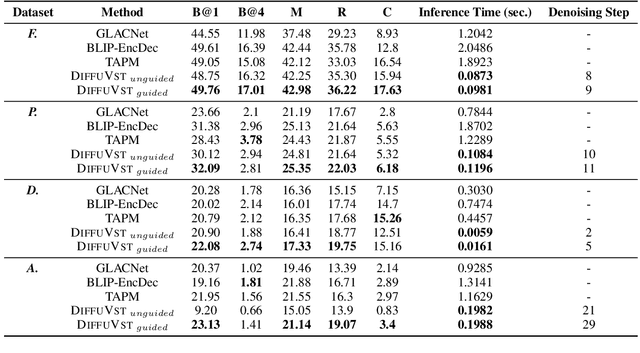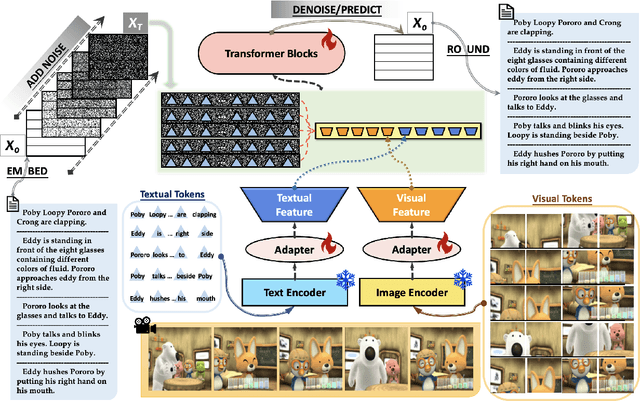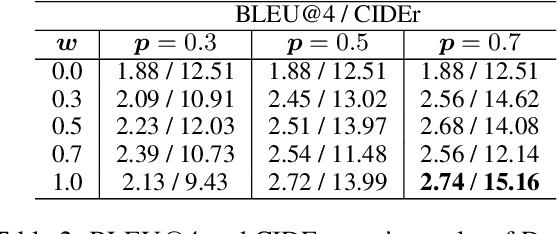Qi Su
Code-as-Monitor: Constraint-aware Visual Programming for Reactive and Proactive Robotic Failure Detection
Dec 05, 2024



Abstract:Automatic detection and prevention of open-set failures are crucial in closed-loop robotic systems. Recent studies often struggle to simultaneously identify unexpected failures reactively after they occur and prevent foreseeable ones proactively. To this end, we propose Code-as-Monitor (CaM), a novel paradigm leveraging the vision-language model (VLM) for both open-set reactive and proactive failure detection. The core of our method is to formulate both tasks as a unified set of spatio-temporal constraint satisfaction problems and use VLM-generated code to evaluate them for real-time monitoring. To enhance the accuracy and efficiency of monitoring, we further introduce constraint elements that abstract constraint-related entities or their parts into compact geometric elements. This approach offers greater generality, simplifies tracking, and facilitates constraint-aware visual programming by leveraging these elements as visual prompts. Experiments show that CaM achieves a 28.7% higher success rate and reduces execution time by 31.8% under severe disturbances compared to baselines across three simulators and a real-world setting. Moreover, CaM can be integrated with open-loop control policies to form closed-loop systems, enabling long-horizon tasks in cluttered scenes with dynamic environments.
CHisIEC: An Information Extraction Corpus for Ancient Chinese History
Mar 22, 2024



Abstract:Natural Language Processing (NLP) plays a pivotal role in the realm of Digital Humanities (DH) and serves as the cornerstone for advancing the structural analysis of historical and cultural heritage texts. This is particularly true for the domains of named entity recognition (NER) and relation extraction (RE). In our commitment to expediting ancient history and culture, we present the ``Chinese Historical Information Extraction Corpus''(CHisIEC). CHisIEC is a meticulously curated dataset designed to develop and evaluate NER and RE tasks, offering a resource to facilitate research in the field. Spanning a remarkable historical timeline encompassing data from 13 dynasties spanning over 1830 years, CHisIEC epitomizes the extensive temporal range and text heterogeneity inherent in Chinese historical documents. The dataset encompasses four distinct entity types and twelve relation types, resulting in a meticulously labeled dataset comprising 14,194 entities and 8,609 relations. To establish the robustness and versatility of our dataset, we have undertaken comprehensive experimentation involving models of various sizes and paradigms. Additionally, we have evaluated the capabilities of Large Language Models (LLMs) in the context of tasks related to ancient Chinese history. The dataset and code are available at \url{https://github.com/tangxuemei1995/CHisIEC}.
Restoring Ancient Ideograph: A Multimodal Multitask Neural Network Approach
Mar 11, 2024Abstract:Cultural heritage serves as the enduring record of human thought and history. Despite significant efforts dedicated to the preservation of cultural relics, many ancient artefacts have been ravaged irreversibly by natural deterioration and human actions. Deep learning technology has emerged as a valuable tool for restoring various kinds of cultural heritages, including ancient text restoration. Previous research has approached ancient text restoration from either visual or textual perspectives, often overlooking the potential of synergizing multimodal information. This paper proposes a novel Multimodal Multitask Restoring Model (MMRM) to restore ancient texts, particularly emphasising the ideograph. This model combines context understanding with residual visual information from damaged ancient artefacts, enabling it to predict damaged characters and generate restored images simultaneously. We tested the MMRM model through experiments conducted on both simulated datasets and authentic ancient inscriptions. The results show that the proposed method gives insightful restoration suggestions in both simulation experiments and real-world scenarios. To the best of our knowledge, this work represents the pioneering application of multimodal deep learning in ancient text restoration, which will contribute to the understanding of ancient society and culture in digital humanities fields.
Small Language Model Is a Good Guide for Large Language Model in Chinese Entity Relation Extraction
Feb 22, 2024Abstract:Recently, large language models (LLMs) have been successful in relational extraction (RE) tasks, especially in the few-shot learning. An important problem in the field of RE is long-tailed data, while not much attention is currently paid to this problem using LLM approaches. Therefore, in this paper, we propose SLCoLM, a model collaboration framework, to mitigate the data long-tail problem. In our framework, We use the ``\textit{Training-Guide-Predict}'' strategy to combine the strengths of pre-trained language models (PLMs) and LLMs, where a task-specific PLM framework acts as a tutor, transfers task knowledge to the LLM, and guides the LLM in performing RE tasks. Our experiments on a RE dataset rich in relation types show that the approach in this paper facilitates RE of long-tail relation types.
An Effective Incorporating Heterogeneous Knowledge Curriculum Learning for Sequence Labeling
Feb 21, 2024Abstract:Sequence labeling models often benefit from incorporating external knowledge. However, this practice introduces data heterogeneity and complicates the model with additional modules, leading to increased expenses for training a high-performing model. To address this challenge, we propose a two-stage curriculum learning (TCL) framework specifically designed for sequence labeling tasks. The TCL framework enhances training by gradually introducing data instances from easy to hard, aiming to improve both performance and training speed. Furthermore, we explore different metrics for assessing the difficulty levels of sequence labeling tasks. Through extensive experimentation on six Chinese word segmentation (CWS) and Part-of-speech tagging (POS) datasets, we demonstrate the effectiveness of our model in enhancing the performance of sequence labeling models. Additionally, our analysis indicates that TCL accelerates training and alleviates the slow training problem associated with complex models.
Knowledge-Aware Artifact Image Synthesis with LLM-Enhanced Prompting and Multi-Source Supervision
Dec 13, 2023



Abstract:Ancient artifacts are an important medium for cultural preservation and restoration. However, many physical copies of artifacts are either damaged or lost, leaving a blank space in archaeological and historical studies that calls for artifact image generation techniques. Despite the significant advancements in open-domain text-to-image synthesis, existing approaches fail to capture the important domain knowledge presented in the textual description, resulting in errors in recreated images such as incorrect shapes and patterns. In this paper, we propose a novel knowledge-aware artifact image synthesis approach that brings lost historical objects accurately into their visual forms. We use a pretrained diffusion model as backbone and introduce three key techniques to enhance the text-to-image generation framework: 1) we construct prompts with explicit archaeological knowledge elicited from large language models (LLMs); 2) we incorporate additional textual guidance to correlated historical expertise in a contrastive manner; 3) we introduce further visual-semantic constraints on edge and perceptual features that enable our model to learn more intricate visual details of the artifacts. Compared to existing approaches, our proposed model produces higher-quality artifact images that align better with the implicit details and historical knowledge contained within written documents, thus achieving significant improvements across automatic metrics and in human evaluation. Our code and data are available at https://github.com/danielwusg/artifact_diffusion.
DiffuVST: Narrating Fictional Scenes with Global-History-Guided Denoising Models
Dec 12, 2023



Abstract:Recent advances in image and video creation, especially AI-based image synthesis, have led to the production of numerous visual scenes that exhibit a high level of abstractness and diversity. Consequently, Visual Storytelling (VST), a task that involves generating meaningful and coherent narratives from a collection of images, has become even more challenging and is increasingly desired beyond real-world imagery. While existing VST techniques, which typically use autoregressive decoders, have made significant progress, they suffer from low inference speed and are not well-suited for synthetic scenes. To this end, we propose a novel diffusion-based system DiffuVST, which models the generation of a series of visual descriptions as a single conditional denoising process. The stochastic and non-autoregressive nature of DiffuVST at inference time allows it to generate highly diverse narratives more efficiently. In addition, DiffuVST features a unique design with bi-directional text history guidance and multimodal adapter modules, which effectively improve inter-sentence coherence and image-to-text fidelity. Extensive experiments on the story generation task covering four fictional visual-story datasets demonstrate the superiority of DiffuVST over traditional autoregressive models in terms of both text quality and inference speed.
Self-Evolved Diverse Data Sampling for Efficient Instruction Tuning
Nov 14, 2023Abstract:Enhancing the instruction-following ability of Large Language Models (LLMs) primarily demands substantial instruction-tuning datasets. However, the sheer volume of these imposes a considerable computational burden and annotation cost. To investigate a label-efficient instruction tuning method that allows the model itself to actively sample subsets that are equally or even more effective, we introduce a self-evolving mechanism DiverseEvol. In this process, a model iteratively augments its training subset to refine its own performance, without requiring any intervention from humans or more advanced LLMs. The key to our data sampling technique lies in the enhancement of diversity in the chosen subsets, as the model selects new data points most distinct from any existing ones according to its current embedding space. Extensive experiments across three datasets and benchmarks demonstrate the effectiveness of DiverseEvol. Our models, trained on less than 8% of the original dataset, maintain or improve performance compared with finetuning on full data. We also provide empirical evidence to analyze the importance of diversity in instruction data and the iterative scheme as opposed to one-time sampling. Our code is publicly available at https://github.com/OFA-Sys/DiverseEvol.git.
ReFlow-TTS: A Rectified Flow Model for High-fidelity Text-to-Speech
Sep 29, 2023Abstract:The diffusion models including Denoising Diffusion Probabilistic Models (DDPM) and score-based generative models have demonstrated excellent performance in speech synthesis tasks. However, its effectiveness comes at the cost of numerous sampling steps, resulting in prolonged sampling time required to synthesize high-quality speech. This drawback hinders its practical applicability in real-world scenarios. In this paper, we introduce ReFlow-TTS, a novel rectified flow based method for speech synthesis with high-fidelity. Specifically, our ReFlow-TTS is simply an Ordinary Differential Equation (ODE) model that transports Gaussian distribution to the ground-truth Mel-spectrogram distribution by straight line paths as much as possible. Furthermore, our proposed approach enables high-quality speech synthesis with a single sampling step and eliminates the need for training a teacher model. Our experiments on LJSpeech Dataset show that our ReFlow-TTS method achieves the best performance compared with other diffusion based models. And the ReFlow-TTS with one step sampling achieves competitive performance compared with existing one-step TTS models.
Automatic lobe segmentation using attentive cross entropy and end-to-end fissure generation
Jul 24, 2023



Abstract:The automatic lung lobe segmentation algorithm is of great significance for the diagnosis and treatment of lung diseases, however, which has great challenges due to the incompleteness of pulmonary fissures in lung CT images and the large variability of pathological features. Therefore, we propose a new automatic lung lobe segmentation framework, in which we urge the model to pay attention to the area around the pulmonary fissure during the training process, which is realized by a task-specific loss function. In addition, we introduce an end-to-end pulmonary fissure generation method in the auxiliary pulmonary fissure segmentation task, without any additional network branch. Finally, we propose a registration-based loss function to alleviate the convergence difficulty of the Dice loss supervised pulmonary fissure segmentation task. We achieve 97.83% and 94.75% dice scores on our private dataset STLB and public LUNA16 dataset respectively.
 Add to Chrome
Add to Chrome Add to Firefox
Add to Firefox Add to Edge
Add to Edge